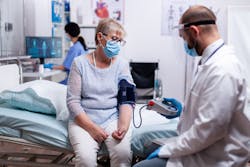Four healthcare organizations, AMGA (American Medical Group Association), End Sepsis, Health Care Improvement Foundation (HCIF), and Medical University of South Carolina (MUSC), have joined the Coalition to Improve Diagnosis, which already includes more than 60 healthcare and patient advocacy organizations.
Convened in 2015 and led by the Society to Improve Diagnosis in Medicine (SIDM) and supported by the Gordon and Betty Moore Foundation, the Coalition to Improve Diagnosis is a confederation of diverse healthcare organizations focused on improving the diagnostic process. Together, they work to find solutions that enhance diagnostic quality and safety, reduce harm and ultimately, ensure better health outcomes for patients.
In September 2018, the coalition launched ACT for Better Diagnosis by calling on organizations to identify and spread practical steps to better ensure diagnoses are accurate, communicated and timely. The organizations now behind the effort represent clinicians, patients, health systems, researchers and testing professionals—all acknowledging that improvement will require sustained work over several years with all stakeholders involved.
SIDM launched the DxQI Seed Grant Program in 2020 to stimulate innovation in a field where quality improvement activity is lagging, and to elevate the importance of addressing diagnostic error within healthcare delivery systems. Each annual cohort (approximately 20 grantees) will receive approximately $1 million in budget-justified grants capped at $50,000 each to support specific quality improvement work directed towards improving diagnosis. In just one example from the first cohort, Brigham and Women’s Hospital is developing an ambulatory safety net program to ensure patients at risk for cancer have highly reliable, closed-loop systems in place for management of abnormal test results. Brigham and Women’s Hospital will measure success by increasing the number of patients with follow-up care plans in place.
The call for proposals for the second year of the program will open in January 2021.
SIDM also has released a new online toolkit to support diagnostic quality and safety researchers in developing patient-centered comparative effectiveness research (CER) and an interactive diagnostic process map to support education about the diagnostic process as conceptualized by the National Academies of Sciences, Engineering, and Medicine in a consensus report, Improving Diagnosis in Health Care.
The CER toolkit is the result of a Patient-Centered Outcomes Research Institute (PCORI)-funded and SIDM-convened “Diagnostic Researcher Workshop” that brought together patients and families, researchers, and others to learn about conducting patient-engaged CER.
“Comparative effectiveness research is a type of research focused on finding solutions, instead of on describing problems,” said Suz Schrandt, SIDM senior patient engagement advisor, in a statement. Schrandt added that by integrating the patient and family voice into research design, we can be sure to study the issues that really matter to patients and their families. “By examining diagnostic errors experienced by families and asking ‘what if?’ we can glean important research questions that can help determine strategies to reduce diagnostic errors and improve diagnostic quality and safety.”
The diagnostic process diagram is a resource developed by the National Academies in their report and offered as an interactive tool by SIDM to help everyone understand and work to improve the diagnostic process. SIDM is also releasing a presentation template that can help users map errors against the National Academies diagnostic process diagram and discuss drivers of errors and steps that could prevent future errors.


